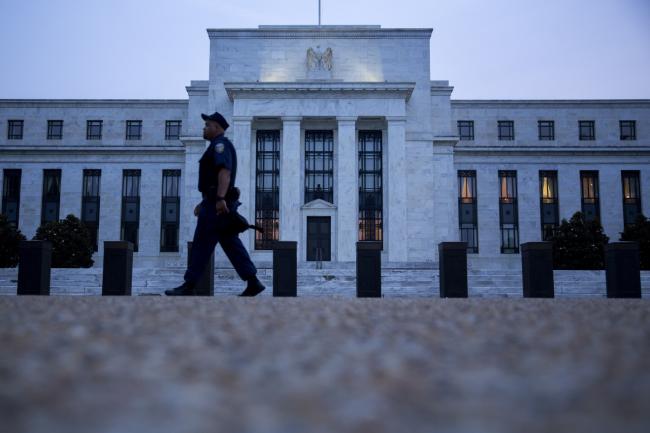 © Bloomberg. A Federal Reserve police officer walks past the Marriner S. Eccles Federal Reserve building in Washington, D.C., U.S. Photographer:Andrew Harrer/Bloomberg
© Bloomberg. A Federal Reserve police officer walks past the Marriner S. Eccles Federal Reserve building in Washington, D.C., U.S. Photographer:Andrew Harrer/Bloomberg (Bloomberg) — The Federal Reserve may have taken a break but it hasn’t finished raising interest rates, according to a new Bloomberg survey of economists.
Respondents to the poll pushed back the timing of expected rate hikes in 2019, but not the total number, sticking with a forecast for two moves. A majority said they now expect those to come in June and December, instead of March and September, as predicted in a similar survey a month ago.
The Federal Open Market Committee will conclude a two-day gathering in Washington on Wednesday. Its policy statement will be released at 2 p.m., followed 30 minutes later by a press conference with Chairman Jerome Powell, inaugurating his new approach of holding a media briefing after every meeting. Officials will not release fresh quarterly forecasts.
“The labor market remains extremely tight and that’s simply not likely to change throughout 2019,” said Stephen Latin-Kasper, an economist at the National Truck Equipment Association. That, he said, will keep wages rising and consumer spending strong enough to justify at least two increases.
Investors reacted negatively in December when the Fed penciled in two rate increases for 2019. Markets calmed when Fed officials, including Powell, reassured nervous investors by saying the Fed would be patient and flexible in its approach to additional rate hikes.
In contrast to economists, investors have interpreted those statements as signaling more than just a pause in rate hikes. Pricing of federal funds futures contracts imply an expectation for no hikes in 2019.
Economists also expect the FOMC to make only small adjustments to their post-meeting statement.
‘Further Gradual’
In December, the committee said they still saw the need for “some further gradual increases” in rates. Two-thirds of respondents said officials would alter that line to signal greater uncertainty about the need for further hikes, or replace it with a reference to being “patient.” Just 5 percent thought officials would drop the line entirely.
A strong majority, 71 percent, said they believed officials would stick with an assessment of the risks as “roughly balanced.” Just 21 percent thought this would change to say risks were tilted to the downside.
Tilting risks to the downside could spook the markets, even if international economic factors already point that way, said Thomas Costerg, senior U.S. economist at Pictet Wealth Management.
“They’ve already acknowledged in the statement that they are monitoring international economic and financial conditions,” he said. “They would rather instill a degree of confidence, and they can use the press conference to discuss all that” rather than trying to fine tune the statement, he added.
Economists also showed they mostly sided with the Fed on the impact of the central bank’s ongoing balance sheet reduction. For weeks, markets have been sensitive not only to the idea that the Fed would continue to raise interest rates, but also to the steady runoff of assets from the balance sheet.
Though officials eventually signaled an openness to altering the runoff if their hand were forced, Powell made it clear he didn’t think that would be the case. On Jan. 4, he said he didn’t believe the balance sheet runoff was “an important part of the story of the market turbulence that began in the fourth quarter last year.”
About 85 percent of economists agreed with that. The same percentage said they didn’t expect the central bank to slow or stop the balance sheet runoff this year.
“The Fed will continue to run off the balance sheet as long as markets are orderly,” said Christopher Low, chief economist at FTN Financial. “Pausing rate hikes should be enough to calm investors.”
Source: Investing.com




























